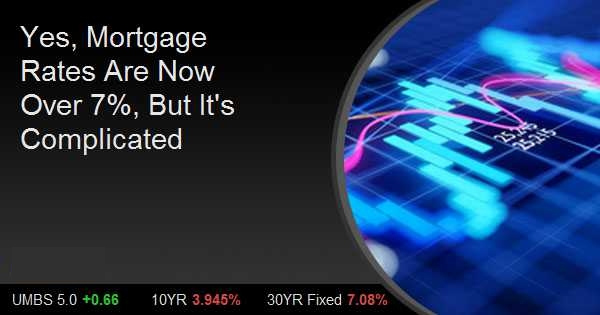Yes, Mortgage Rates Are Now Over 7%, But It's Complicated
It's no mystery that mortgage rates have been moving relentlessly higher in 2022. But how high is high? That will depend on a number of factors, including:
- The date and time of day of the quote (things change quickly)
- The lender in question (different lenders have slightly different pricing and can have vastly different quoting practices)
- The specifics of the scenario (loan-to-value ratio, loan purpose, credit score, etc)
- The presence of "points" and other upfront costs in the rate quote.
For our purposes today, we're mainly focused on the presence of points and, to a lesser extent, the variations between lenders. As always, any rate you see in a major rate index or survey will assume essentially no "hits" (no upward adjustments to the rate or the upfront costs due to the particulars of your scenario).
The same is true of our daily rate tracking, which is now over 7%. But it's important to note that you may or may not actually see a rate quote of over 7%. To truly understand why, you'd need a basic understanding of how mortgage-backed securities (MBS) translate to mortgage rates (there's a primer for that).
If you don't click the primer, here's an attempt to distill a tome into a paragraph: MBS are bonds comprised of multiple mortgages. They're offered in 0.5% increments called coupons. Each coupon is like a bucket that can contain a certain range of mortgage rates with +1.125% being the upper limit.
In other words, an MBS coupon of 6.0 would be required for a mortgage rate of 7.125 (6.0 MBS coupon +1.125%). A 5.5 MBS coupon could not facilitate rates any higher than 6.625% (5.5 + 1.125).
The problem is that 6.0 MBS coupons only existed in the history books up until last week. Even then, it takes a tremendous amount of time and market stability for new coupons to be liquid (i.e. to have plenty of buyers and sellers, thus making the true price very apparent at any given moment).
Mortgage lenders rely on MBS prices as the key ingredient in determining rates. But the liquidity problems mean lenders can't know exactly how to price rate quotes near 7% (because the MBS price that determines what they can offer is a moving target). Not only that, but MBS prices in general are not offering "premium." That's an amount above and beyond the principal balance of a loan that an investor pays in exchange for earning more interest over time. When rates are stable, premium allows lenders to cover many of the upfront costs that mortgage borrowers are presently surprised to be encountering.
That brings us to the bottom line on 7% not necessarily being 7%. Most rate quotes and most major rate indices include upfront "points" or other cost assumptions (and in larger amounts than normal). The presence of points means you could definitely still get 6.625% today. You'd just be paying more for it upfront.
In fact, for some lenders, that's your best bet because you'd actually be paying MORE for a higher rate! Yes, this seems crazy, but again, rates are based on MBS prices, and if investors are paying more for a 6.625% mortgage than 7.125%, the former will be a better deal. This isn't the case at every lender because different lenders "guess" at the moving target of those higher coupon MBS (the stuff that isn't liquid yet, thus making true price discovery a guessing game).
The presence of points in mortgage rate quotes is problematic--especially in the last 6-9 months as the value of a point exploded from 0.25% in rate to 0.5-.75% in rate depending on the day and the lender. A rate quote of 6.625% with 1 point is conveyed as "6.625%" in headlines, but that extra point represents extra interest expense the same way a higher rate would. There are different ways to translate points to rate, but based on the average value of a point at the average lender, a "no point" rate would be over 7% today.





